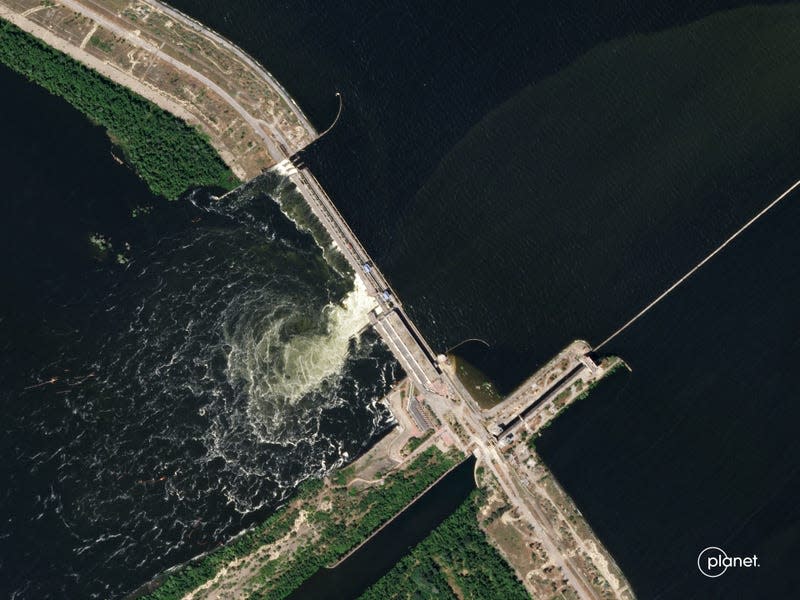Space Business: Cold Storage
When NASA chose SpaceX’s Starship to land the first astronauts on the Moon since 1972, its rival Blue Origin protested the decision, making an argument about pre-flight reviews that was rejected.
Blue Origin, founded by Jeff Bezos, had choice words about the plans provided by Elon Musk’s SpaceX. For context: To get Starship to the Moon, the vehicle must be refueled in space before leaving Earth’s orbit. That requires multiple other Starships to be launched as tankers, in order to top off the orbiting lander with super-cold liquid oxygen and methane. That procedure, per Blue, “is undeveloped technology and has never been proven to work.”
Read more
Now, that technology has to work to put US astronauts back on the Moon. Blue Origin won a $3.5 billion contract to build a second human landing system for NASA, and its design also depends on transporting, storing and transferring cryogenic propellants in space.
“[Blue Origin’s new contract] is a different mission with different requirements—including a later landing date—than the original ... target of 2024,” Sara Blask, a Blue Origin spokesperson, told Quartz in an emailed statement. “Refueling and transfer would be challenging for that original timeline.”
The challenge: Without strong gravity, fluids separate and don’t naturally flow in any one direction. Still, creating pressure to transfer propellants—through motion, with pumps, or with changes in temperature—is straightforward for propellants that are stable as liquids. The International Space Station’s propulsion system is regularly refueled with hypergolic fuels, which are propellants that combust on contact with each other. Those substances, however, are highly toxic to humans and expensive to obtain.
Modern rockets typically burn oxygen and fuels like high-test kerosene, methane or hydrogen. To maximize efficiency, these typically gaseous substances are stored as incredibly cold liquids—below -297 °F for oxygen, and -256 °F for methane—which allows more to be kept in a smaller area. But that also means their storage systems require temperature controls and are built of special materials to withstand high pressure.
One of the biggest challenges with SpaceX’s biggest Falcon 9 rocket was managing the storage of cryogenic propellants—one anomaly led to the destruction of a satellite partially financed by Facebook. In 2019, NASA attempted to demonstrate the transfer of cryogenic propellants at the International Space Station, but the chilling system failed and the liquid methane “boiled off”—turned to gas and was vented into space.
“What a pain,” Joe Laurienti, the CEO of space propulsion firm Ursa Major, said when I asked about Blue Origin’s plan to use cryogenic propellants in its new lander. The Apollo program, he noted, didn’t use cryogens because of the difficulties managing their storage; his company is building engines that work with both room temperature and ultra-chilled propellants. But NASA’s ambitions to bring large payloads back and forth from the lunar surface—Moon-base style ambitions—may require the extra power cryogens provide.
SpaceX didn’t respond to questions about its in-space refueling, and Blue Origin declined requests for interviews about their plans. But one of Blue Origin’s partners on the lander program is Lockheed Martin, which is tasked with developing and operating a spacecraft that will carry cryogenic propellants from the Earth to the Moon to refuel Blue Origin’s lander.
The Cislunar Propellant Transporter will be a huge vehicle, some 34 meters long and launched in two parts by Blue Origin’s as-yet-to-fly New Glenn rocket. The idea is that once Blue’s lander reaches orbit around the Moon, it will remain there to shuttle astronauts down to the surface and back again. Afterward, it can be refueled and perform its next mission.
Kirk Shireman is the Lockheed executive in charge of the program, and concedes that cryogenic refueling is difficult, but says his company has the technology to solve the problem. NASA has separately hired Lockheed to demo cryogenic refueling in space, originally scheduled for later this year. (If you’re interested in helping out, the company is now advertising a position supervising the assembly, test, and launch operations for this mission.)
Lockheed has long thought about this problem, mainly because of its investment in United Launch Alliance, the rocket maker it co-owns with Boeing. Executives there came up with plans to use part of the Atlas rocket as a reusable space tug. While those ideas have fallen by the wayside, ULA CEO Tory Bruno, a former Lockheed exec, recently proposed the creation of a “strategic propellant reserve” in orbit. “We’re confident this is possible and practical,” Bruno told me last year.
Space advocates are a bit obsessive about in-space refueling. It’s seen as the enabler for long-term exploration of the solar system, particularly if oxygen and hydrogen can be harvested from ice on the Moon. Shireman, a former manager of the International Space Station, notes that 60% of the station’s costs are transporting payloads from the Earth. Keeping reusable (and therefore refuel-able) infrastructure in space is a critical way to reduce that cost.
“It’s the key to our future,” Shireman says of his current project. “The investment we are making here certainly applies to taking humans to the Moon, but it also plays forward ... These same elements can be used to go beyond the Moon as well.”
🌕🌖🌗
IMAGERY INTERLUDE
The latest development in the war for Ukraine is the failure of the Kakhovka dam, apparently destroyed by an internal explosion while under Russian control. The human and ecological disaster is still unfolding, and satellites are watching from above. These images were collected by Planet before the dam’s failure on June 4, and afterward, on June 6.


SPACE DEBRIS
SpaceX wins Pentagon Starlink deal. The Department of Defense is purchasing Starlink terminals and service from SpaceX for use by the Ukrainian military after previous disputes over the cost of providing internet access there since Russia’s invasion. No details were released about this contract, but it represents a key win for SpaceX’s telecom business. It’s been quite a journey since February 2022 when, according to documents Quartz obtained through a FOIA request, a SpaceX executive emailed a contact at USAID to ask, “Any chance you have contacts at the communications regulator in Ukraine or any other countries?”
Starliner needs non-NASA customers. Boeing announced last week that its plans to fly astronauts on its Starliner spacecraft would be delayed by two new flaws in the vehicle’s design. The company isn’t likely to profit from its current NASA contract, so it needs to figure out how to fly Starliner on a different rocket and win some private customers if the program is to succeed financially.
SLS needs non-NASA customers. Boeing’s Space Launch System did the job on the Artemis 1 mission, but a recent audit (pdf) showed the cost of the rocket continues to rise and is now at $4.2 billion per launch. Boeing and Northrop, which makes the vehicle’s solid rocket boosters, hope to cut that figure in half, but even that might not make up for anemic demand.
Europe and China launch commercial space transportation efforts. The European Space Agency and the Chinese Manned Space Engineering Office are planning partnerships with private companies to transport cargo to low-earth orbit, but they may not be investing enough. Also: a rundown of potential European bidders.
Earth observation’s impact is real. Two examples caught my eye. First, the New York Times published a fascinating investigation into Russian sanctions dodging using a variety of satellite data to track “dark ships”; second, the US is nearing a deal to reduce enormous methane leaks in Turkmenistan that were discovered (and are monitored by) private satellites.
Last week: The science behind those polarizing unidentified flying objects.
Last year: NASA’s Capstone mission paves the way for lunar infrastructure.
This was issue 184 of our newsletter. Hope your week is out of this world! Please send tips, bets on the in-space refueling race, and informed opinions to tim@qz.com.
More from Quartz
Sign up for Quartz's Newsletter. For the latest news, Facebook, Twitter and Instagram.


